Mark Sisson's Blog, page 238
December 29, 2015
PRIMAL KITCHEN™ Salad Dressings Now Available (Plus a Free Bottle for You)
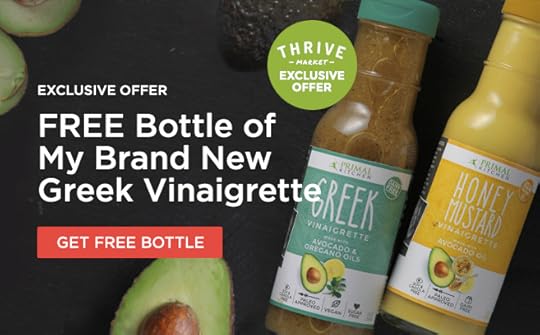 As the end of the year rolls around, I always like to reflect and assess…did I stay in 80/20 balance, was I an exemplar model of a modern caveman…you know, that sort of thing. I realize I’ve been a bit of an overachiever in 2015…and I’m proud of it! We’ve got new Primal Blueprint Publishing books out to rave reviews and you’ve probably heard I launched a line of paleo/Primal foods, PRIMAL KITCHEN™, that’s exceeded my expectations in growth and reception. PRIMAL KITCHEN™ Mayo keeps selling like hotcakes, the Avocado Oil is going strong, my Dark Chocolate Almond Bars literally crashed PrimalBlueprint.com on launch day, and I have two new PRIMAL KITCHEN™ offerings to share with you before we bid adieu to 2015.
As the end of the year rolls around, I always like to reflect and assess…did I stay in 80/20 balance, was I an exemplar model of a modern caveman…you know, that sort of thing. I realize I’ve been a bit of an overachiever in 2015…and I’m proud of it! We’ve got new Primal Blueprint Publishing books out to rave reviews and you’ve probably heard I launched a line of paleo/Primal foods, PRIMAL KITCHEN™, that’s exceeded my expectations in growth and reception. PRIMAL KITCHEN™ Mayo keeps selling like hotcakes, the Avocado Oil is going strong, my Dark Chocolate Almond Bars literally crashed PrimalBlueprint.com on launch day, and I have two new PRIMAL KITCHEN™ offerings to share with you before we bid adieu to 2015.
Drum roll please…say hello to Primal Kitchen’s first two salad dressings—Greek Vinaigrette and Honey Mustard Vinaigrette!
What makes PRIMAL KITCHEN™ stand out is that we’re striving for more than just great taste, and yes, these vinaigrettes really do taste terrific. The PRIMAL KITCHEN™ mission is to make healthy eating easy and exciting. In the world of real-food eating, meat and vegetables can get pretty boring—it’s the sauces and condiments that keep healthy eating interesting. And let’s be honest, we’re all trying to eat more greens and veggies. But sometimes it’s hard, especially with sugar-laden, seed oil-tainted dressings overflowing grocery aisles everywhere.
So we use 100% pure avocado oil in both of our vinaigrettes. We source our avocado oil from premium Spanish avocados that are organically grown (but pending certification, so we can’t officially call our avocado oil organic yet). It’s first cold pressed and never mixed with hexane, and then centrifuge extracted to preserve the nutritional properties of the oil. You’ve heard me sing the praises of avocado oil multiple times, so I’ll just give you the main takeaways:
It boosts the nutrient absorption of foods it’s paired with, particularly carotenoids.
It’s made of healthy fats, primarily oleic acid, shown to help reduce “bad” cholesterol levels in your blood and lower your risk of heart disease and stroke.
And it’s packed with antioxidants—vitamins E, K, C, B5, B6, folate, and glutathione to help strengthen immunity.
Both of our vinaigrettes feature organic apple cider vinegar. You’re familiar with its benefits if you’ve ever tried the apple cider vinegar and honey cure when you’re feeling under the weather, but did you know that studies suggest apple cider vinegar may help you lose weight because of its high satiety factor, and may even help increase insulin sensitivity when consumed alongside a high-carb meal? More research is definitely warranted, but animal studies indicate that apple cider vinegar may have the potential to lower high cholesterol, triglycerides, and blood pressure, three contributors to heart disease.
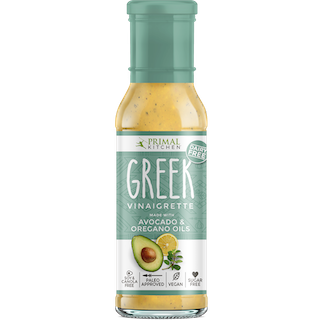 Next up is medicinal oregano oil, featured in PRIMAL KITCHEN™ Greek Vinaigrette. Before there were antibiotics like penicillin, there was oregano oil, and with antibiotic-resistance a growing epidemic, it’s time to look back to age-old remedies such as oregano.
Next up is medicinal oregano oil, featured in PRIMAL KITCHEN™ Greek Vinaigrette. Before there were antibiotics like penicillin, there was oregano oil, and with antibiotic-resistance a growing epidemic, it’s time to look back to age-old remedies such as oregano.
Oregano oil is packed with vitamins A, C, E, K, B6, and folate, calcium, potassium, iron and magnesium. It has one of the highest ORACs among all food sources. On a per gram fresh weight basis, its is…
42 times more potent than an apple’s
30 times more potent than a potato’s
12 times more potent than an orange’s
4 times more potent than blueberries
Oregano oil contains carvacol and thymol—two powerful phytochemicals with antimicrobial and antibacterial capabilities. In fact, an in vitro study demonstrated that against E. coli, possibly lowering the effective antibiotic dose and subsequent side effects. The specific source of our organic oregano oil happens to contain the highest carvacol percentage on the market. It’s good stuff.
Greek Vinaigrette Ingredients: Avocado Oil, Organic Red Wine Vinegar, Organic Apple Cider Vinegar, Sea Salt, Organic Black Pepper, Organic Oregano, Organic Coriander, Organic Marjoram, Organic Lemon Juice Concentrate, Organic Oil of Oregano
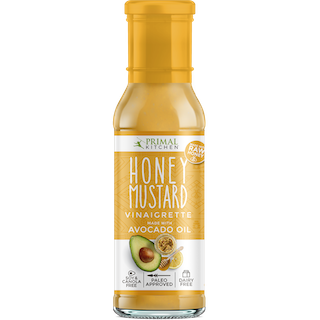 My Honey Mustard Vinaigrette features organic honey with the pollen still intact. Some companies use processes that strip pollen out of honey. But organizations like the World Health Organization and the European Commission have ruled that without pollen in the honey, there’s no way to determine if it came from legitimate and safe sources. And rest assured every ounce of honey in my Honey Mustard Vinaigrette has been sourced, tested, and packaged based on the highest standards in the industry.
My Honey Mustard Vinaigrette features organic honey with the pollen still intact. Some companies use processes that strip pollen out of honey. But organizations like the World Health Organization and the European Commission have ruled that without pollen in the honey, there’s no way to determine if it came from legitimate and safe sources. And rest assured every ounce of honey in my Honey Mustard Vinaigrette has been sourced, tested, and packaged based on the highest standards in the industry.
Both of my salad dressings are made with real food, organic ingredients—from sea salt to lemon—and are always free of refined sugar, dairy, soybean, gluten and trans fats, so you can indulge guilt free. And you should! Pour on top of all your salads, or use them as dipping sauces or to flavor up your favorite meat dishes. I’d love to hear the creative ways you use PRIMAL KITCHEN™ Salad Dressings in the comments below, so please reach out and let me know once you’ve had a chance to try them.
Honey Mustard Vinaigrette Ingredients: Avocado Oil, Filtered Water, Organic Apple Cider Vinegar, Organic Stone Ground Mustard (Organic Apple Cider Vinegar, Organic Mustard Seed, Water, Salt, Organic Spices) Sea Salt, Organic Honey, Organic Lemon Juice Concentrate
As a thank you for your loyalty, I’ve partnered with Thrive Market, and they’re giving away a FREE bottle of PRIMAL KITCHEN™ Greek Vinaigrette to all new Thrive members while supplies last. You’ll just have to pitch in $1.95 for shipping. And if you’re already a Thrive Market member, you’re in luck. Every purchase of $50 or more gets a free bottle of my Greek Vinaigrette, and, like always, shipping is free.
Click here to be one of the first to enjoy my new paleo-approved salad dressings for free.
Or head on over to the Primal Blueprint website and grab a 3-pack or sign up for the autoship program, and enjoy the free shipping perks.
I have a feeling we’re going to have another grand sellout, so hurry and grab your free bottle while supplies last.




December 28, 2015
Dear Mark: Easy Prebiotic Foods, NSAIDs and the Gut Bacteria, Plus Some Hydration Questions
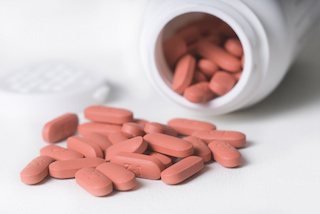 For today’s edition of Dear Mark, I’m answering a bunch of questions from readers drawn from the comment sections. First, is there a better, whole foods-based alternative to prebiotic powders, meals, and flours? Turns out there are many, and I give a few of my favorites. Next, what’s the deal with NSAIDs and the gut? Everyone knows they increase leaky gut, but can they also affect the gut biome directly? I finish up by answering several readers questions regarding hydration. Can stevia replace syrup in the hydration solution I posted? Does anything change for post-menopausal women? Does milk work?
For today’s edition of Dear Mark, I’m answering a bunch of questions from readers drawn from the comment sections. First, is there a better, whole foods-based alternative to prebiotic powders, meals, and flours? Turns out there are many, and I give a few of my favorites. Next, what’s the deal with NSAIDs and the gut? Everyone knows they increase leaky gut, but can they also affect the gut biome directly? I finish up by answering several readers questions regarding hydration. Can stevia replace syrup in the hydration solution I posted? Does anything change for post-menopausal women? Does milk work?
Let’s go:
Mark,
Can you give some good, practical examples of prebiotic foods? I am taking in resistant starch in the form of potato starch and it seems to be beneficial (or at least not harmful) but I know there are other options as well. I just don’t think I can eat that much raw garlic (or the people around me would appreciate it).
Any suggestions on ways to get other prebiotics in or supplements (inulin?)
Thanks,
Mike
Sure, there are tons of whole foods prebiotics, most of them delicious, easily accessible, and more nutritious than their equivalent in refined fibrous powders.
Instead of potato starch, eat green (or greenish) bananas and/or cooked and cooled potatoes. Potato starch is great, but it’s just resistant starch. Green bananas and cooked and cooled potatoes both give you RS plus potassium, magnesium, and a spectrum of different fibers. Cooked and cooled potato salad is a great way to get RS.
Instead of inulin powder, eat Jerusalem artichokes (fartichokes), onions, leeks, or chicory root. They are whole foods and will provide ample micronutrients.
Eat nuts and seeds. Modest amounts of most nuts and seeds will help. Almonds and pistachios seem to have the most prebiotic potential, while macadamias are quite low in any fiber at all.
Don’t forget about “animal fiber.” That’s the gristle, the cartilage, the chewy bits at the end of chicken bones that can have prebiotic effects in our guts. Plus, animal fiber provides the all-important collagen that so many modern eaters are missing from their diets.
Just eat a wide variety of plant matter. Some broccoli here, some Brussels sprouts there, a handful of blueberries, some almonds and pecans, a roasted kabocha squash, a Big Ass Salad for lunch—that sort of thing. In addition to different types of fiber, colorful fruits and veggies also provide polyphenols, which can have prebiotic effects.
And yeah, I’d lay off the raw garlic. While a couple cloves are definitely beneficial (and may even paradoxically improve your body odor), eating enough to get the prebiotic benefits is a stretch.
I’m surprised you didn’t address the negative effects of NSAIDS on the gut, or do NSAIDS affect the gut wall directly and not the biome?
Yes and no.
When gut-aware people typically caution against NSAID overuse, they focus on their ability to directly damage the intestinal lining. This is a big problem, to be sure. NSAIDs can worsen gut barrier dysfunction and increase intestinal permeability in patients with IBS (who frequently take it to deal with the symptoms). An animal study indicates that NSAID overuse may even increase gluten sensitivity by “potentiating” its barrier dysfunction.
There’s also definite evidence that NSAIDs can directly change the gut biome.
This direct effect on gut bacteria isn’t unique to NSAIDs. As Art Ayers put it recently, “all drugs are antibiotics.” Almost every pharmaceutical (and many “natural” products) interacts with the gut biome on some level. Many drugs were designed as antibiotics or derived from natural compounds whose original owners—plants—used them to fend off microbial attacks. For instance:
Some chemotherapy drugs are antibiotics. A common side effect of chemotherapy is gut dysbiosis.
Statins have antibiotic effects, and the first statins were discovered by a Japanese doctor developing antibiotics.
Metformin causes “profound changes” to users’ gut bacteria.
Proton pump inhibitors (PPIs) decrease gut microbial diversity.
So NSAIDs are not alone. And it may be that these drugs, which many people take chronically, are more responsible for widespread antibiotic resistance than antibiotics, which are usually taken for just a week or two.
Two questions:
1. Does stevia count as “sugar” in the water? Carbs kill me no matter where they come from, or why I consume them.
2. What about post-menopausal women–what should THEY do lacking a luteal phase?
Unfortunately, as it has no calories stevia doesn’t work for the purposes described in the hydration post. For those who haven’t read it, I gave a quick recipe for a hydration formula: a pinch of salt and a teaspoon of maple syrup added to water. The salt provides much-needed electrolytes and the syrup provides glucose and fructose to facilitate the absorption of water through small channels in the intestines. The sugar is not going toward caloric requirements in the strict sense. It’s fueling the cells absorbing the water. Do you think a single teaspoon—4 grams of sugar—will really be too much for you? Maybe, but I doubt it.
Also, remember that this recipe is intended for athletes and other people engaged in serious training, often in warm conditions promoting heavy fluid loss. If you’re taking it easy, the salt/sugar solution is probably unnecessary. If you’re going hard enough to warrant this solution, you’ll burn right through any errant milligrams of glucose that make it past.
What about post-menopausal women? The same solution applies. My point in mentioning it was that sodium requirements may be elevated in some women during the luteal phase, so they should take special care to obtain enough sodium when exercising. If you’re post-menopause, you can still benefit from the solution, but it may not be as critical.
How about milk?
Actually not a bad idea. A surprising amount of evidence supports milk’s hydrating abilities.
In kids, drinking milk beats drinking water for hydration.
For post-workout recovery and hydration, milk beats sports drinks. If you’re lactose intolerant, lactose-free milk even works.
Milk being effective isn’t all that surprising. Breastfed babies live entirely off the stuff, obtaining all the electrolytes and fluids they need to stay hydrated, even in hot climates.
To sum up, on a hot day a glass of lukewarm milk may feel like a bad choice, but it will definitely hydrate you. Just make sure you’re tolerant; explosive diarrhea has the opposite effect on hydration.
That’s it for today, folks. Thanks for reading! Be sure to throw any tips or responses you have down below!




December 27, 2015
Weekend Link Love – Edition 380
 Research of the Week
Research of the WeekThe genetic link between physical activity and health.
Scientists can determine how many cats, dogs, men, and women live in a household by analyzing the bacteria content of its dust.
Obesity may be worse than a lack of fitness.
Nine in ten cancers may be caused by lifestyle or environment (as opposed to genes).
New Primal Blueprint Podcasts

Episode 99: Katy Bowman: Host Brad Kearns sits down with renowned biomechanist Katy Bowman to chat about healthy human movement patterns, the perils of excessive exercise, why exercise can’t replace movement, and why the Don’t Just Sit There movement is gaining so much traction.
Each week, select Mark’s Daily Apple blog posts are prepared as Primal Blueprint Podcasts. Need to catch up on reading, but don’t have the time? Prefer to listen to articles while on the go? Check out the new blog post podcasts below, and subscribe to the Primal Blueprint Podcast here so you never miss an episode.
The Power of Food Rituals
Psychedelics: A New Medical Frontier?
Could Gut Bacteria be to Blame for Your Stubborn Belly Fat?
Also, be sure to check out and subscribe to the Primal Endurance Podcast.
Interesting Blog Posts
Arnold’s Christmas challenge to everyone.
Media, Schmedia
Cycling desks: coming to a university library near you.
US News and World Reports covers the no-poo movement and urges us to eat butter and curb sugar over the holidays. What did Bob Dylan say about the times again?
Everything Else
Is your hipster chocolate a total scam?
The planet isn’t getting enough nutritious animal poop.
The current best basketball player in the world just signed a three year endorsement deal with a water filtration system.
What happens when a coastal people become landlocked?
Should you sleep with your pet?
How to avoid being overwhelmed by email.
Recipe Corner
High-protein post-workout banana mousse.
I bet you’ve never had pumpkin, mahi-mahi, and bacon at the same time. You should.
Time Capsule
One year ago (Dec 29 – Jan 4)
8 Signs You Probably Don’t Need More Protein – More isn’t always better.
End of the Year Review: What We Learned in 2014 – 2014 in review.
Comment of the Week
So Mark, you are not holding back the Primal movement are you?
#sarcasm
– I certainly hope not, HealthyGuy!




December 26, 2015
Dulse “Bacon” and Eggs
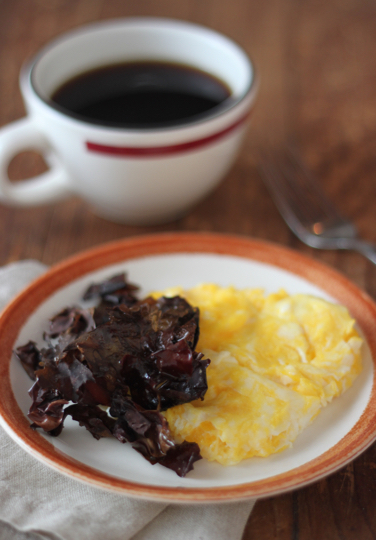 Dulse, a type of red seaweed with high amounts of magnesium and calcium, has gotten some attention for tasting like bacon from the sea. Is it just media hype, or is it possible that dulse (pronounced duhls) really does taste like meaty, salty, fatty bacon?
Dulse, a type of red seaweed with high amounts of magnesium and calcium, has gotten some attention for tasting like bacon from the sea. Is it just media hype, or is it possible that dulse (pronounced duhls) really does taste like meaty, salty, fatty bacon?
Dried, whole leaf dulse can be eaten right out of the bag. It’s a bit chewy, tastes very salty, a little smoky and has that fresh-from-the-ocean seaweed flavor. When dulse is heated in a skillet with a little oil, it changes. The texture gets crispy, the seaweed flavor fades and the smokiness get stronger. It does indeed have some bacon-like qualities.
Even so, if you expect the dulse to taste exactly like bacon you’ll be disappointed. There is nothing like bacon…except bacon. But if you taste pan-fried dulse with a forkful of scrambled eggs and an open mind, you’ll be pleasantly surprised by how well the smoky, salty flavor pairs with eggs. It’s not exactly like traditional eggs and bacon, but it’s a breakfast that’s good in its own right.
Is pan-fried dulse something you ‘ll start eating instead of bacon? Probably not. But in addition to bacon when you crave something similar but lighter? Definitely.
Servings: 2
Time in the Kitchen: 10 minutes
Ingredients:
2 handfuls dried whole leaf dulse (approximately .7 oz/20 g)
1 to 2 tablespoons neutral flavored oil, like cold-pressed high-oleic/high-stearic sunflower oil (30 ml)
4 eggs, whisked
Instructions:
Over medium heat, warm the oil in a skillet.
Pull the leaves of the dulse apart somewhat, so they’re a little more spread out. Add the dulse to the skillet and push it around gently with a spatula to coat it in oil.
Cook for about 3 minutes, until the color begins to change and the dulse starts getting crispy.
Take the dulse out of the skillet and let cool.
Add more oil (or some butter) to the skillet and cook the scrambled eggs.
Serve the scrambled eggs with pan-fried dulse “bacon” on the side.
Pan-fried dulse can also be crumbled over salad or added to trail mix.
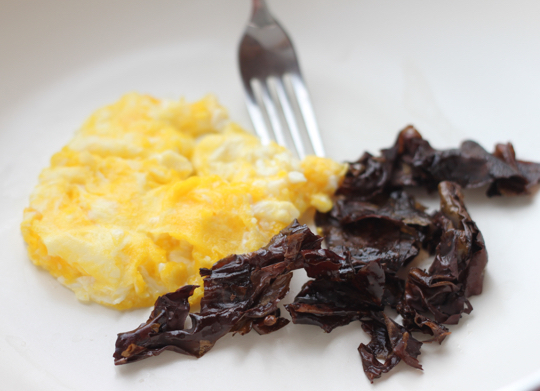




December 25, 2015
My Primal Journey of Success and Failure
Merry Christmas, everyone! It’s Friday, and that means another Primal Blueprint Real Life Story from a Mark’s Daily Apple reader. If you have your own success story and would like to share it with me and the Mark’s Daily Apple community please contact me here. I’ll continue to publish these each Friday as long as they keep coming in. Thank you for reading!
 A few weeks ago someone wrote in the comment section that they would like to see more “failure” stories on the site. Well, I’d like to submit my failure/success story. So, here I go…
A few weeks ago someone wrote in the comment section that they would like to see more “failure” stories on the site. Well, I’d like to submit my failure/success story. So, here I go…
My name’s Anita and for 5 years now, I have been moving toward a more Primal life. I started by reading Gary Taubes’ Good Calories, Bad Calories and felt so motivated to change. My mom had just died a month before, and she was morbidly obese most of my life. If it weren’t for the fact that she’d lost so much weight being ill, I wouldn’t have been able to nurse her those last few months. That scared me.
I grew up very active being a competitive swimmer as a kid. When I turned 14, I injured my knees and had to give up my swimming career. I was devastated. I turned to drugs, alcohol and cigarettes to fill the void. After four years of poisoning my body, I quit all three cold turkey and haven’t looked back since. Success!
Not quite, from about the age of four or so, I developed a nasty addiction to sugar. I used to sneak pudding cups, whole pies from the freezer, concentrated frozen lemonade and jello packages from the pantry and hide the evidence under the couch, or out in the backyard. Even though I got sick from too much sugar many, many times over the years, I have not successfully given it up.
I have been reading Mark’s Daily Apple for five years. In that time, I’ve managed to ditch shoes and go mostly barefoot all summer. I’ve cleared my pantry of all grains and only have honey in the house. I got rid of plastic and the microwave. I make my own chicken, beef, pork and fish broths and now cook from scratch 99% of the time. I grow my own veggies in the backyard and make my own compost. I purchase two free-range pigs, and a 1/4 free-range cow each year from my friend’s farm. He also supplies us with free-range eggs and non-pasteurized, non-homogenized honey (it’s the stuff I sell). My kids have never taken sandwiches to school and eat only Primal lunches. We sleep in darkened rooms, with the heat down. Those are my Primal successes.
My Primal failure is that over the past year, I have gained 40+ pounds. I found out last December that I would be losing my job sometime in 2015 and my husband told me he was moving out in the spring. Given that we were in full holiday mode, I ate my way through my emotions and the holidays. In January, my office was moved to a remote location and I was physically isolated. I tried to stay positive but it was tough. I was still swimming three times a week and felt I would be okay. Then my husband moved out in late June and I struggled not having the kids in my house; I became a single mom every other week. And I struggle(d) with that new identity. Enter sugar. It comforted me, and made me feel so hungover, but I felt it would get me through.
Six weeks later after he moved out, I lost my job. I was okay with that as I had 14 years of experience, and had confidence I would land a job in another department with the same company. Then I got a phone call six weeks later, in mid-September, from my doctor asking me to have a mammogram due to my family history. The results of that mammogram lead to a lumpectomy in mid-November. I struggled with my confidence in interviews and wasn’t aggressive enough in my resumes. As a result, I haven’t found a job. But I did find sugar and pizza to help me through. The biopsy came back negative (no cancer!) which is great. But I am now 10 days away from my severance ending with this company. And I’m now 40+ pounds heavier.
So, what have I done wrong? I’ve given into this sugar addiction when I felt I couldn’t cope. At times I don’t care and have just gone crazy with it. I still read MDA daily but feel like I’m a poor representative of Primal living. I’ve given up exercising because I keep injuring myself and frankly, I haven’t felt like it at times. I’ve stayed up later than I should which makes me CRAVE sugar the next day making it hard to not give in.
What have I done right? I still read MDA every day and it gives me hope. I still cook from scratch and eat in a very Primal way, save for my extra sugar and junk intake. If I eliminate those, the weight would come right off. I’ve stopped making excuses. I see what I’m doing and am taking ownership. I do five double leg pull-ups each day, 10 wall push-ups and 10 second planks. That’s all I can manage right now, as I heal from my surgery and nurse these other injuries.
I’m hoping at some point to kick this sugar addiction. For me, it has to be 100% off added sugar. Anything less than that and the physiological response is too great, and I feel like I’m going mental if I don’t quiet the screaming urge for sugar. I hope to get there some day and I’ve now got friends supporting me in this goal.
I’ve included 1 picture of me, taken in August of this year. Since this time, I’ve probably gained 15 pounds. But I’m not ashamed of my “failure.” I do see this as a learning opportunity, and I know that this is a far better way of living than I had five+ years ago. Even if I have gained weight, I know my body is still benefiting from all the Primal eating I do.
For anyone struggling with an addiction, seek an outside group to help you through. And know you’re not alone. I still love the Friday Success Stories because they give me hope that someday I might shed the weight again.
I wish you all the best on your Primal journey.
Anita

Like This Blog Post? Subscribe to the Mark's Daily Apple Newsletter and Get 10 eBooks and More Delivered to Your Inbox for FREE



December 24, 2015
Do You Have Something To Look Forward To?
 This time of year it’s fun to remember the Christmases when my kids were young, and I’d venture many of us can recall similar experiences—whatever holiday they were part of. The night before, each of them would be practically leaping out of their own skin in excitement. Falling asleep was a near impossibility as they laid in their beds anticipating the next morning—finding the cookies they’d left for the man in red (with carrots for the reindeer) half-eaten, seeing the colorful wrapped gifts under the tree, wondering what new and fun thing they’d be creating fantastical scenarios with. It was their giddy, animated exhilaration that was so fun to observe—their imaginative suspense about how it would all reveal itself. When was the last time you felt anything close to that in your life? When was the last time you really looked forward to something—felt the thrill of anticipation?
This time of year it’s fun to remember the Christmases when my kids were young, and I’d venture many of us can recall similar experiences—whatever holiday they were part of. The night before, each of them would be practically leaping out of their own skin in excitement. Falling asleep was a near impossibility as they laid in their beds anticipating the next morning—finding the cookies they’d left for the man in red (with carrots for the reindeer) half-eaten, seeing the colorful wrapped gifts under the tree, wondering what new and fun thing they’d be creating fantastical scenarios with. It was their giddy, animated exhilaration that was so fun to observe—their imaginative suspense about how it would all reveal itself. When was the last time you felt anything close to that in your life? When was the last time you really looked forward to something—felt the thrill of anticipation?
Too often, I think, we relegate true, heady enthusiasm to childhood as if we should be beyond that level of emotional engagement by the time we’re old enough to vote, get a mortgage and pay taxes. Life at that point, we assume, becomes about responsibility and security more than lofty visions. For those with children, it might feel even more of a duty to relinquish “our turn” with exhilaration—to unconsciously pass down and pass on the anticipatory fantasies so we can focus on grounding “real” life with all the practical necessities for our families.
And, yet, I think we do ourselves an injustice when we do so.
Because I think it’s essential at every age to have something to look forward to. Some even say it’s the key to happiness.
I’m not talking about the graspy, stubborn entitlement that convinces us we deserve X, Y or Z and that life won’t be worth living without any or all of the above. I’d personally file that mindset under immaturity.
What I do mean is continually risking a vision in life. We don’t give up the right to ask for what we want—let alone to dig in and realize what that even is—the day we declare ourselves (or society defines us) as adults. And, sure, we can “want” a given material thing (and, man, does the outside culture relentlessly push that this time of year!). While there’s nothing at all inherently wrong with that, I’m really talking about a grander ambition here.
When we were young, those “sugar plum” visions (e.g. chocolate snowmen, Legos, Light Brite or whatever it was for you) was enough to fuel hours of fantasy. What would make life genuinely more fulfilling, more exciting, more enriching, more breathtaking for you at this point in your adulthood?
Typically, most people have things they’ve always wanted to experience, that they’ve put off for one reason or another, that they always considered out of reach. And, yet, part of them sits at that toy shop window, peering in at the display that showcases that something they’ve always pined for. What is it that keeps you looking and wondering?
What would give you something new to live and work for—beyond the daily diligence toward basic security? Is it taking the trip of a lifetime? Is it being in top shape? Is it losing 40 pounds? Is it moving into the new career field you’ve always wanted—or going back to school? Is it taking back your health from chronic pain or fatigue? Is it having more time with your family or moving to a new destination that offers you more of the lifestyle you want?
As we head into the holidays this week, take some time to think about that for yourself. Give yourself what I would call the gift of intention—of something to look forward to. And if that vision has anything to do with health, vitality, fitness or fulfillment, keep our upcoming 21-Day Challenge (that starts January 11th) in your back pocket—and stay tuned for more directions, guidance, contests, prizes and more. A great way to begin a new year—and a new vision if I do say so myself.
Happy holidays, everyone! I hope you share what you are looking forward to this coming year. Enjoy your week and celebrations.




December 23, 2015
8 Reasons Why Low-Carb Diets Actually Work
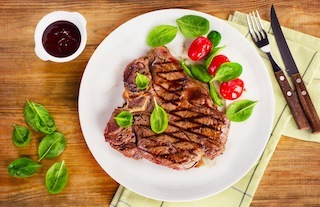 The popular story of how low-carb diets work goes something like this:
The popular story of how low-carb diets work goes something like this:
Reducing your carbohydrate intake lowers your insulin levels. Since insulin keeps fat locked into adipose tissue, lowering insulin can increase the amount of fat released to be burned for energy.
For the portion of the overweight/obese population with insulin resistance and chronically-elevated insulin levels, this is a fairly accurate description of why low-carb diets work so well. When you’re an insulin-resistant hyper responder in whom even a baked potato can cause elevated, protracted spikes in insulin that hamper fat-burning for long periods of time, or a person living under the backdrop of perpetually-elevated insulin, dropping the most insulinogenic foods can be your way out of obesity.
But that doesn’t explain everyone’s positive experience with low-carb diets. There are many other mechanisms by which low-carb diets exert their beneficial effects on bodyweight and body composition. Let’s take a look:
They increase protein.
Increasing protein intake has many beneficial effects on health, particularly if you’re attempting to lose weight. Of all the macronutrients, protein increases satiation the most. This means a low-carb diet replete in protein can help control your appetite naturally. I wouldn’t say “effortlessly,” because deciding to eat more meat and fewer carbs technically requires executive functioning. But you’re no longer fighting your own body’s physiological desire for more food. You just don’t want anymore.
More protein also helps you retain, or even gain, lean mass during weight loss. Why does this matter? Because nobody’s trying to lose muscle, bone, or connective tissue when they lose weight. They want to lose body fat and keep or add muscle. Studies show that more protein in the diet consistently leads to greater retention of lean mass and more preferential burning of body fat during weight loss. For instance in weightlifters, a low-carb hypocaloric diet with 2x the RDA for protein resulted in greater nitrogen balance than a high-carb hypocaloric diet with RDA protein. In women, a low-calorie, high-protein diet was better than a conventional high-carb, low-fat diet at promoting lean mass retention, even in the absence of exercise. This increased lean mass also contributes to a greater resting energy expenditure, helping you burn more calories simply through daily existence.
Protein also has the highest thermic effect of all the macronutrients, meaning it takes the most calories to digest and further increases your energy expenditure.
They increase fat.
Fat in a meal slows gastric emptying, especially when fewer carbs are eaten. When your food takes longer to pass through your gut, you stay fuller longer. When you’re full, you’re not interested in eating. When you’re not interested in eating, your calorie intake spontaneously drops. When you calorie intake spontaneously drops, you tend to lose weight.
They reduce sugar.
In and of itself sugar isn’t “toxic.” It’s just pure energy absent any real micronutrition, and as long as you’re highly active and regularly clearing space in your glycogen stores for incoming glucose and fructose, a moderate amount is mostly harmless. Heck, I have a teaspoon in my coffee every day. In energy-replete humans—which is a significant portion of the population—excess sugar becomes deleterious. If the liver is full of glycogen, any fructose arriving there is converted to fat and contributes toward fatty liver or elevated blood lipids. If fatty liver progresses unchecked, this has terrible consequences for a person’s metabolic health, insulin sensitivity, glucose tolerance, and waistline.
Because sugar is the most obvious carb to remove from one’s diet, low-carb diets reduce sugar by default and minimize the possibility of fructose-induced metabolic dysfunction.
They deplete glycogen.
Glycogen is how we store sugar in the body, and our capacity is limited. Larger muscles can store more glycogen, but the average person can count on being able to store about 400 grams of carbs between skeletal muscle and liver glycogen. Walking around with your glycogen stores perpetually topped off means there’s nowhere for excess carbohydrate to go. You either burn it immediately or convert it into fat for storage in the liver.
Carb reduction drastically reduces glycogen. That’s part of the reason we initially lose so much water weight on low-carb diets; water always accompanies glycogen. Glycogen depletion is the “switch” for the brain and body to begin utilizing fat for energy. Given access to fast and easy glycogen, it’ll choose to burn that first. Take it away through glycogen depletion (via training, low-carb, or some combo of the two) and you have no choice but to feast on your own adipose tissue.
They’re easy to understand and follow.
Everyone knows what “carbs” are. Potatoes, pasta, bread, soda, sweets, that sort of thing. It’s not hard to figure out. And it’s really hard to “hide” carbs like you can hide fat. Either the food is obviously starchy or obviously sweet, and you know to avoid it.
Low-carb is delicious. Eating steak, steamed broccoli with butter, and sautéed mushrooms doesn’t feel like dieting. It feels like cheating. Meanwhile, Weight Watchers, ultra-low fat diets, macrobiotic vegan diets—these are diets in the worst sense of the word. And you’ll never forget it when you’re on one.
You can certainly dig deeper into the minutiae, but the basic advice—eat fewer carbs, stop drinking soda, and pass on the donuts—gets most people most of the way.
They work fast.
Severely overweight person drops carbs, increases fat/protein, and quickly loses ten pounds in the first week. It’s a common occurrence. I’ve seen it happen, and it almost always turns the weight-loss recipient into a believer who adheres to the diet for the long haul. It doesn’t hurt that much of the early low-carb fat loss comes off the belly (the most conspicuous place for adipose tissue).
Like the best exercise regimen, the best diet is the one you’ll stick to—the one you’re excited about. Diets seem to fail so much in the literature because people can’t or won’t adhere to them. But those big early victories on the scale—even if it’s “just” water weight—and along the waistline motivate dieters to keep carbs down and keep losing body fat.
They increase nutrient density and reduce caloric density.
When you go low-carb, you ask for salad instead of the dinner roll. You load up on sautéed spinach instead of French fries. You eat kale chips instead of potato chips. These subtle alterations don’t just reduce the amount of carbs and calories you eat. They increase the density of micronutrients and phytochemicals you consume, many of which have favorable metabolic effects. There’s also evidence that increasing the micronutrient density of your diet can improve weight loss.
They eliminate the most fattening foods.
The most self-perpetuating macronutrient combo, the one you can’t stop eating, is fat plus carbs. Cheesecake? Tons of fat and tons of sugar. Potato chips? Fat and starch. Reducing carbs takes this combo out of the equation entirely. It’s much harder to overeat fat without carbs. And even if they mistakenly refer to high-fat-and-carb foods like chips and donuts as “carbs,” it doesn’t matter. They’re still eliminating the problematic foods that are the most obesogenic. A huge plate of fettucine alfredo probably has as much fat as carbohydrate, but “avoiding carbs” avoids the pasta just as well as “avoiding large boluses of carbs and fat in the same meal.”
Some would say that you could just as easily remove fat to make carbs less addictive. That’s true (although I’m not sure how “easily” that’s accomplished). But we’re talking about why low-carb diets work today.
That’s what I’ve got today. What about you guys? Why do low-carb diets work so well in your opinion?




December 22, 2015
The Power of Food Rituals
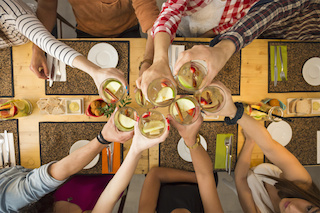 From the intricacy of Japanese tea ceremonies to the ornateness of holiday dinners, food related customs hold big sway in every culture. They all reflect in some way an element of that culture’s values and common story—whether long inherited or deliberately chosen. While some of our rituals can be traced to particular religious traditions, others are more secularly instituted, family oriented or even individually constructed. Those grander social customs might evoke more conscious nostalgia, but science suggests even the small practices we enact around our eating can have surprising results.
From the intricacy of Japanese tea ceremonies to the ornateness of holiday dinners, food related customs hold big sway in every culture. They all reflect in some way an element of that culture’s values and common story—whether long inherited or deliberately chosen. While some of our rituals can be traced to particular religious traditions, others are more secularly instituted, family oriented or even individually constructed. Those grander social customs might evoke more conscious nostalgia, but science suggests even the small practices we enact around our eating can have surprising results.
Food ritual, of course, is literally written in our genetic expectations. In fact, how meat in particular was cut and shared over hundreds of thousands of years has been a central clue in how anthropologists track cultural evolution. Relics of early human culture highlight the magnitude of it. From the use of certain kinds of dishes for particular foods and drinks to the thoughtful, extravagant spreads for communal feasting, for example, shared food ritual came before the Agricultural Revolution, serving then (and today) as a integral tool for establishing and maintaining social cohesion.
But the impact isn’t just social….
Instructing subjects to perform a given ritual before eating University of Minnesota researchers constructed experiments in which they instructed one half of people to perform a simple ritual before eating an assigned food and gave the other group no such instruction except to relax for a time before eating.
Those who performed the ritual (literally just dividing and unwrapping a chocolate bar a certain way) reported more satisfaction from the eating experience. They not only assessed the chocolate as more tasty, but they took longer to eat it and reported being willing to pay more for it.
A second experiment revealed that a longer delay between ritual and eating enhanced the experience of the food further still. Even with carrots, the subjects reported enjoying the taste more after the longer ritual-delay interval. (Maybe Aunt Sylvie’s drawn-out prayers over the holiday dinner aren’t so bad after all.)
It’s important to note is that participation in the ritual was necessary as is “intrinsic interest.” It’s not enough to observe someone else do something (e.g. carve the turkey) or to do a ritual expecting an extra reward (e.g. “If I make myself bless the food I’ll let myself have an extra dollop of cream on my pie.). We have to let ourselves perform the practice for practice’s sake. This means letting go of the incessant distractibility, our reductive utilitarianism and our modern cynicism.
In fact, research on ritual suggests the more elaborate our rituals, the more effect they have on us. It’s just a hallmark of the human mind. As researchers explain, “[T]he characteristics of ritual are the product of an evolved cognitive system.” What appeals to our imagination often has more power than what addresses our intellect. Ritual, scientists have observed, is used by both animals and humans to alleviate anxiety.
Our modes of engaging with our experiences include more than strict empirical reasoning. They call upon eons of human history in which ritual evoked peace, belonging and safety. We’d do well to learn from traditional societies’ (and some contemporary religious groups’ flow experience with ritual. It’s not about the particular stories behind these but the universal forms our species evolved with.
And it has the power to reframe our relationship with food as well as pleasure.
Interested in seeing what they can do for your enjoyment, ease and fulfillment? (That’s the good life after all….)
Start simple by appreciating the ritual you already practice. Do you set the table a certain way? Do you make your coffee or tea way? Do you bring certain habits meals or meal prep? There’s a reason cooking can be a meditative art for some people. For all our focus on convenience food, we deny ourselves more than we know by scarfing down sandwiches in parking lots or grabbing plates so everyone can retreat to their separate corners of the house.
Just go with what you believe would add to the enjoyment of your food that’s about your own behavior rather than the food itself. Another irony of modern life: we’ll pay insane amounts of money to bring home five star food but give ourselves a zero star eating experience. Everyone’s personal taste varies, but this principle holds: bring mindfulness to the table first. It’s the difference between letting yourself receive the food versus unconsciously inhaling it.
As you sit down with family for the holiday, why not resurrect old (and funny) mealtime patterns from your early years. Take time for whatever prayer, blessings, story sharing or pre-eating custom has meaning for you and your family. If the typical religious practices aren’t your thing, hold hands and ask each person to go around and say something they’re grateful for this year (do we seriously need to limit gratitude Thanksgiving?) or read a poem, sing something or even simply observe a minute of silence together. What practice would get everyone involved and celebrate the community preparation to eat?
Thanks for reading, everyone. What food rituals have you observed—in the everyday sense or within holiday celebration? I’d love to hear your thoughts and practices. Have a good end to your week.




December 21, 2015
Dear Mark: Meat and Yogurt for Babies
 For today’s edition of Dear Mark, I’m answering one question. It comes from Kristen, a new mother to a nine month-old who’s grown so passionate about baby nutrition that she’s decided to start a fresh food business for infants and toddlers. She’s a recent reader of the blog, though, and as such needs a little help understanding the role animal foods like meat and yogurt can play in infant feeding. For many years, the importance of meat in an infant’s diet was downplayed, denied, or ignored in pediatric nutritional guidelines. We now know that’s wrong and kids can really benefit when their first solids include animal products. Today, I explore exactly why it matters so much.
For today’s edition of Dear Mark, I’m answering one question. It comes from Kristen, a new mother to a nine month-old who’s grown so passionate about baby nutrition that she’s decided to start a fresh food business for infants and toddlers. She’s a recent reader of the blog, though, and as such needs a little help understanding the role animal foods like meat and yogurt can play in infant feeding. For many years, the importance of meat in an infant’s diet was downplayed, denied, or ignored in pediatric nutritional guidelines. We now know that’s wrong and kids can really benefit when their first solids include animal products. Today, I explore exactly why it matters so much.
Let’s go:
Hi!
I am a mother to a nine month old, and have been developing a passion for baby nutrition. I am in the beginning phases of starting a fresh, organic baby food company that is made to order and locally sourced. My husband recently turned me on to your blog and the primal lifestyle. I am learning a lot, and I find all of your articles to be extremely fascinating.
My goal is to make the best possible food for babies and toddlers, with the same ease and convenience of store bought food.
I was wondering if I could get Mark’s guidance and opinion on meat and whole yogurt in a baby’s diet. Are there resources that you trust when developing a meal plan for babies and toddlers?
Thank you for your time.
Kristen
Excellent question (and excellent business idea, if you can do it right). Meat is very important for babies entering the weaning phase. Most parents seem to focus on cramming their kids full of rice puffs and various gruels. Even well-meaning “real food” parents tend to ignore the importance of meat to focus on sweet potatoes, avocados, kale, and the like. Those are good foods. Those are important foods. They just can’t replace meat. The studies are pretty clear on this.
In a recent study in rural Chinese infants, subjects were given one of two complementary foods starting at 6 months of age: cereal or meat. Those who ate meat as a complementary food experienced better linear growth than the cereal group.
Last year, a study found that a high protein intake from meat as a complementary food increased growth but not adiposity in breastfed infants living in Denver. And complementary feeding of red meat in particular can improve markers of blood hemoglobin and hematocrit in infants.
Another study found that kids who ate meat as a first food obtained more than twice as much zinc as kids who ate cereal. Zinc is crucial for brain growth and, indeed, zinc intake tracked quite closely with head growth. Even when grains appear to be high in zinc, the zinc from animal foods is more easily absorbed. As one team of Italian researchers put it, “Zinc requirements for older breastfed-only infants are unlikely to be met without the regular consumption of either meats or zinc-fortified foods.” Since zinc-fortified foods are a recent creation, meat was the likeliest—and only—choice for most of human history.
A 2003 review by a (vegetarian-friendly) anthropologist examining the critical role meat-eating served in human evolution makes a powerful case for including meat in infants’ diets. Animal foods provided the relevant micronutrient- and calorie-density required for optimal growth and survival. They’re easy to digest. There’s very little “wasted” matter in a piece of meat or a slice of liver or a hunk of animal fat. It’s all consumed, digested, and metabolized into useable energy. Wild plant foods, while nutrient-dense and important, contain too much fiber and too few calories to be the primary food source for a growing human child.
We all accept that meat is extremely beneficial to large humans. Why not tiny ones? Meat, and animal foods in general like egg yolks, contain crucial nutrients for human growth, health, and happiness like iron, zinc, protein, fats, and vitamin A. Get them to eat liver every once in awhile and you’re giving that kid the best multivitamin around.
Yogurt is another good food. Earlier this year, a randomized controlled trial found that giving kids aged 12-48 months yogurt with inulin (a prebiotic fiber) reduced instances of fever and improved both social and school functioning. However, the synbiotic (yogurt and prebiotic) group also had more days with watery stool. When it’s introduced in the first year of life, yogurt seems to protect against the development of atopic dermatitis later in life. Yogurt is a safe and effective treatment for acute diarrhea in children aged 6-24 months.
Yogurt isn’t as crucial as meat. Most research has focused on yogurt as a therapeutic rather than complementary food in young children, but this indicates that yogurt is certainly safe for babies. From my reading of the literature, it’s probably good for them too.
Even though you didn’t mention it, fish has a place in an infant’s diet. It’s best to focus on smaller oily fish, which are lower on the food chain and therefore accumulate fewer heavy metals, are less expensive than larger fish, and provide a nice variety of important nutrients like calcium (if bone in), iron, zinc, iodine, and omega-3s. And if you can get a kid to dig bone-in sardines, you can probably get him to eat anything.
Introducing fish around the nine month mark (so get on it if you haven’t already!) may protect against eczema and other allergic diseases. According to another study, the window of opportunity for protection from asthma lies between the sixth and twelfth months.
The best resource for determining the best meal plan for a baby or toddler is the baby or toddler himself. Baby-led weaning is a big thing—and the best way to “train” kids to eat real food. You can leverage this for your business. Get a wide variety of kids together and feed them a variety of foods. If your peers have kids around the same age, bring them around and feed them. See what the kids prefer. Try your best to make a winning liver dish. Do that and you’ll have gold on your hands. Do this every week or every other week and take good notes; this is the best focus group around. They won’t lie. They won’t hold back. They won’t tell you what they think you want to hear. They are the perfect expression of id—pure instinct.
Beyond that, checking the scientific literature is important. That’s precisely what I did (and regularly do) for this answer. Despite the considerable evidence for including it in a baby’s complementary diet, few “official” and popular sources of infant nutrition information emphasize meat. You’ll have to look for it (it’s there).
Good luck with the business. Let me know how it goes!
Thanks for reading, everyone. If you’ve got any input on baby food, baby meat (that didn’t come out right), or giving babies yogurt or other complementary foods, leave it down below. Take care!
Like This Blog Post? Subscribe to the Mark's Daily Apple Newsletter and Get 10 eBooks and More Delivered to Your Inbox for FREE



PRIMAL KITCHEN™ Is Hiring – Apply Today!
 Calling all PRIMAL KITCHEN™ enthusiasts! We’re hiring part-time employees in the following cities: San Diego, Los Angeles, Denver, Boulder, Portland and Seattle. If you meet the requirements from the list below, and you’re looking for part-time work with control over your schedule please apply by filling out the application here and emailing a picture of yourself and your resume to sierra@primalkitchen.com.
Calling all PRIMAL KITCHEN™ enthusiasts! We’re hiring part-time employees in the following cities: San Diego, Los Angeles, Denver, Boulder, Portland and Seattle. If you meet the requirements from the list below, and you’re looking for part-time work with control over your schedule please apply by filling out the application here and emailing a picture of yourself and your resume to sierra@primalkitchen.com.
Requirements:
You love hanging out in Whole Foods or your local natural grocery store
You have an outgoing personality and you’re incredibly charming and fun
You live a Primal lifestyle
You have a general understanding of why avocado oil is the best oil—and you’re not afraid to educate shoppers
You like to talk
You have wheels
You live in Boulder, Denver, Los Angeles, San Diego, Portland or Seattle
You have a smartphone (for recording information from your demo)
Are You Ready to Be a Brand Ambassador? Apply Here.



Mark Sisson's Blog
- Mark Sisson's profile
- 199 followers




